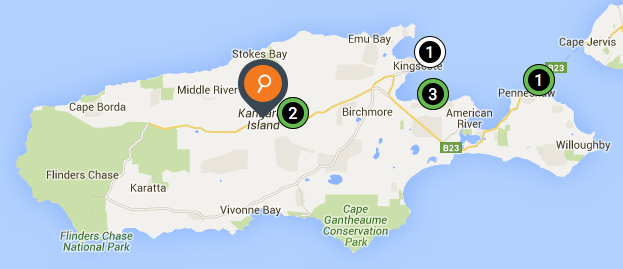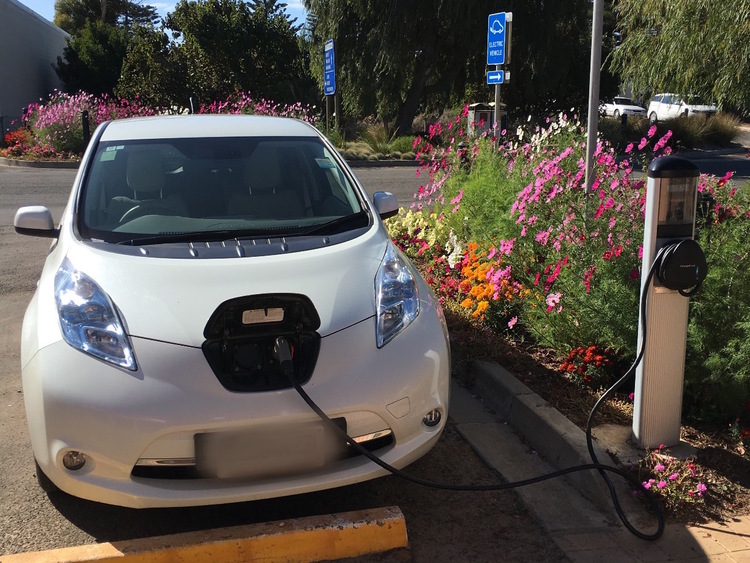My wife and I recently returned from Honeymoon Part 2 on Kangaroo Island in South Australia. This isn’t a travel post though (although it’s a lovely, if somewhat rugged place to go!).
When booking the holiday back in February I looked around for car hire and noticed that one outlet was advertising electric cars. Since Telsa (spoiler: we didn’t get a Telsa) has been in the news for ages and I wanted to learn more about plug in electric vehicles, I figured we’d hire one for a few days and see what it was like to drive one. I went to the trouble of looking at how many charge points there were around the island (one per town on the eastern side of the island, for a total of five) I went ahead and booked a Nissan Leaf.
On arrival the attendant at the rental agency gave us the rundown on how to turn the car on, plug it into the charging point, where the spare cable was to plug it into mains power and then let us loose. The downside is this is where I learned from the dash display that the estimated range was about 130km. The sticker on the windshield said this was the extended range version of the Leaf which should have gotten 170km with a 30KWh battery, but we only got anywhere near that shown to us on one of the charges, the rest of the time it stopped charging around the 130km point.
Range Anxiety
This is the point where the Leaf stopped being an exciting new technology to play with, an instead a resource to be managed.
First, some geography: Kangaroo Island is 150km (93.2 miles) wide, and we were staying on the eastern end of the island. As a result, our driving radius, assuming we wanted to get home again looked something like this (65km radius about our hotel):

The westernmost charging point was at Pardana, around the middle of the island, effectively cutting off the whole of the west coast unless we did a multiple day trip to factor in the time it would take to recharge the car in between legs. Since we’d already booked our accommodation this wasn’t an option. (As an aside, this probably didn’t bother my wife, since all the serious walking tracks are on the west coast, and she is far less keen on bushwalking than I am :)
This turned our trip into a series of calculations about how long we needed to stay in towns with charging stations in order to charge the car up for the trip back to the hotel against how much there was to actually do that was within walking distance. Not exactly ideal for a holiday.
One of the most anxienty-causing aspects of driving the Leaf was that the estimated range was always changing as the battery discharged and charged back up from recaptured energy. Hills were a killer: we would frequently lose 20-30km in range whilst going up a hill which, when the total range is 130-170km, occasionally made me really worried as to whether we’d make it to our destination.
The Charging Experience
There are different levels of charging points that exist in the wild, according to how much juice they can pump into your car. The ChargePoint stations which seem to be used around Australia come in three varieties: around 4KW (apparently similar to what you can get out of household mains), 7KW and 50KW. All of the stations on the island were of the 4KW variety (according to their app they tended to output somewhere around 3.7KW) and so charging our car was slow.
To charge up from half capacity usually took us around 5 hours or more, which is a long time if you’re uncertain about whether you can make it home on what’s left in the battery and need to fill in that time being touristy and doint touristy things entirely on foot.
Although we had a mains capable charging kit in the boot, we never got the opportunity to use it since there wasn’t anywhere you could just drive the car up to and help yourself to someone’s power. At our hotel we were lucky that the charging station was literally across the road from the carpark so that we could go back to our room while the car was plugged in and I could walk over to unplug it when it was done and bring it back.

ChargePoint locations on Kangaroo Island
Charging is a mess. We weren’t told exactly how the charging process worked when we picked up the car beyond where the catch was to open the port on the car, so our first experience was pulling up in front of the charging station. On a scrolling LCD display at the top of the station was the rate at which we would be charged ($2.80/hour[1]) and under the display was the symbol that is commonly used for NFC enabled credit cards.
I figured that this would be easy enough:
- swipe credit card
- plug car in
- get charged when the car was unplugged
I don’t have a credit card, so I swiped my debit card, and got a “card not recognised” message. OK, I borrowed my wife’s credit card and tried again, similarly, “card not recognised”. So I went to the website of the company who runs the stations: ChargePoint. I found out they have an app, so I downloaded it, put my card information into it, it used my phone’s GPS to locate the charging station I was standing next to, communicated with it, and unlocked the handset so that I could plug it into the car. Success!
The app would report how long the car had been on charge, what rate it was charging at, how much power had been transferred to the battery so far, and sent SMS or email notifications on power interruption (e.g. if someone unplugged the car) or when power stopped flowing (in theory - we never had this actually happen).
So where does the mess come in? The app only managed to talk to the charging stations occasionally. Sometimes I could force quit it and relaunch and it would start working, sometimes trying to start charging a few times would get it to work, once I had to log out and log in again. On the final charge we had to do it failed to work at all and we had to resort to the swipe card which by that point we had found out about.
The ChargePoint website looks like it should give you all the functionality of the smartphone app, but I couldn’t figure out how it worked.
After the second full day of futzing around using the app, I saw the sheet tucked into the pocket behind the driver’s seat, which detailed the instructions for using the small RFID card attached to the keyring of the car, which is apparently the only card that the charging stations recognise. Charging using that card also wasn’t charged to us at the end of the rental, so we would have saved ourselves around $30 if we’d been told about that first.

Rented Nissan Leaf
Our rented Nissan Leaf plugged into a ChargePoint station.

Downhill Shakycam
The battery charging as we went down a hill on an unsealed road.
I am a Leaf on the Wind
The Leaf has two drive modes: Regular and Eco. The difference between the two is that Eco brakes more aggressively to reclaim power when you take your foot off the accelerator and doesn’t respect your foot as much when going up hills.
Overall, the Leaf was a really nice car to drive. In regular mode it was quite zippy, and was pretty comparable with my Mazda 3 which is around the same size, and seemed to handle a bit better. Being electric it was super quiet apart from a slight aircraft-like whine as it accelerated. I would say that it was the nicest car that I’ve driven to date.
During the first day of driving my wife and I were discussing what it’d be like to own one, but came to the conclusion that we aren’t really in a location that would be practical: living around 200km from Perth means that it’d be outside our driving range. For local driving it would be perfect, being able to charge up at home and just doing short trips around the city. Looking at what’s available the moment, the Leaf looks to be about the best that is available since most electric cars bar the Teslas have 130km range or less.
Conclusions
My conclusion based on five days of driving around with the Leaf is that I’m really looking forward to the time when it’s practical to own an electric car in Australia. As it stands the range isn’t enough on the more affordable cars to be useful to us if we need to drive between towns, and the Australian government provides virtually no incentive to buy low or zero emission cars, with the Australian Capital Territory (i.e. Canberra) the only state offering any financial incentive in the form of no stamp duty on the purchase. The Tesla cars seem to have the range that we would need at significantly greater cost, which in fact may even attract the luxury car tax (the threshold for which is increased for fuel efficient cars, but at the same time, cars are expensive compared to the US).